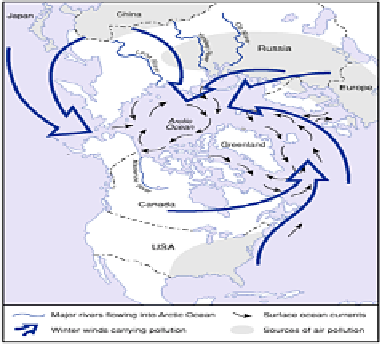Environmental Engineering Reference
In-Depth Information
decommissioning, storage and disposal of nuclear reactors from former Soviet nuclear
submarines at towns such as Murmansk and Archangel on the coast of the Barents Sea.
The tragic loss of two Russian nuclear submarines in the Barents Sea, the
Konsomolts
in
1989 and the
Kursk
in 2000, both with nuclear reactors and nuclear warheads, leaves
another deadly legacy on the sea bed.
Acid precipitation, resulting from the reaction of sulphur and nitrogen oxides with
water vapour, is the best known long-range pollution problem (see Chapter 5). Although
sulphate deposition from acid deposition is less than 3 kg ha
−1
yr
−1
and acid levels are ten
times lower than in industrial temperate areas, a continuous acid load can lead to lower
biological productivity in freshwater lakes and the gradual release of heavy metals, which
are more soluble in acid conditions. About 95 per cent of the input of sulphur into Arctic
regions arrives during the winter months when air currents are more favourable. During
the winter the acids accumulate in the snow; when released by spring melt they can leach
soils and acidify lakes. Most pollutants enter the Arctic Ocean and the Antarctic land
mass by air currents. However, ocean currents, especially the North Atlantic Drift, and
the northward-flowing rivers Ob, Yenisey and Lena in Russia, like the Mackenzie in
Canada, also connect the Arctic ecosystems with industrial regions (Figure 24.10).
ENVIRONMENTAL IMPACTS OF POLAR TOURISM
Polar regions have become an important destination of eco-tourism as visitors are
attracted by the wildlife populations and wilderness values. As with all tourism, however,
there is a danger of the tourists destroying the
Figure 24.10
Pathways for the long-range transport of
pollutants into the Arctic from North America, Europe and
Russian by wind, ocean currents and rivers.
Source: After Twitchell (1991).

